First Consensus Meeting on Menopause in the East Asian Region
Growing rapidly and ageing rapidly, or the tyranny of numbers
Egon Diczfalusy
Karolinska Institute, Stockholm, Sweden
Tolle numerum omnibus rebus et omnia pereunt.
Take from all things their number and all shall perish.
Isidorus Hispalensis,
Archbishop of Seville (560–636 AD)
Introduction
‘The obscurest epoch is today’ said R.L. Stevenson and many of us would tend to agree with him, except for the fact that he said it in 1892. This begs the question: was his time or our time the obscurest epoch? Would perhaps all epochs since the dawn of time qualify for this particular honour? In fact, almost 30 years prior to Stevenson’s statement, Waldo Emerson remarked: ‘These times of ours are serious and full of calamity, but all times are essentially alike.’ However, I beg to differ with Waldo Emerson and emphasize — with the wisdom of hindsight — that all times are not alike, and that our time is fundamentally different from all other times. What is the difference? The rate of change. A rapidly growing and rapidly ageing world population is a new feature in the history of humankind; it is so new that people and their governments have not yet had sufficient time, vision, determination or courage to face up to the likely medical and socioeconomic implications of the demographic reality of a new world that will be very different from all preceding epochs in history.
Although we may not yet be prepared to come to terms with the tyranny of demography, I believe that the time has come to begin to address the major social, cultural and political readjustments that will be necessary to meet this major challenge at both national and international levels, a major challenge that will confront and accompany humankind during its journey through the 21st century.
In times when the changes around us are accelerating, but our perception of those changes and of their likely consequences lags behind, it becomes of crucial importance to have a vision of the future. However, this author is convinced that only those with some knowledge of the past can have a vision of the future. An indispensable and critical part of that knowledge consists of an understanding of the tyranny of numbers and a proper appreciation of the predictive value and limitations of descriptive statistical information. This article will therefore briefly assess some of the relevant global and regional aspects of the demographic history of the second half of the 20th century and will correlate the data with the most likely projections for the first half of the 21st century.
Population growth
The title of this article may succinctly summarize the human condition in the 20th century. The human race entered the 19th century with a global population of 978 million people, the 20th century with 1650 million people, and it will enter the 21st century with a worldwide population of 6168 million [1]. Growth was relatively slow during the first half of the 20th century, so that global population was just barely above 2.5 billion (2520 million) in the year 1950; however, growth then accelerated and the world population reached 3700 million in 1970, and 5630 million in 1994 [1].
At the present time, we are witnessing the most rapid population growth in the history of the human race with a yearly increment of some 88 million people (Table I). However, it is projected that by the year 2050 the yearly increments will be reduced to below 50 million.
Table I: Annual increment of the world population (millions) [1].

What will happen after the turn of the century? The United Nations projects that humankind will enter the 21st century with a global population of 6.2 billion people. Its projections for world population for the next 150 years are shown in Figure 1.
The rapid growth rate will continue for some time and by the year 2025, the world population is projected to be around 8.3–8.5 billion people. It is projected that the growth rate will slow down after 2025, and even more so after the year 2075, so that the global population in the year 2100 should be around 11.2 billion and in 2150 perhaps 11.5 billion people.
Fig. 1: Estimates and projections of the world population between 1950 and 2150. Medium fertility projection [1].
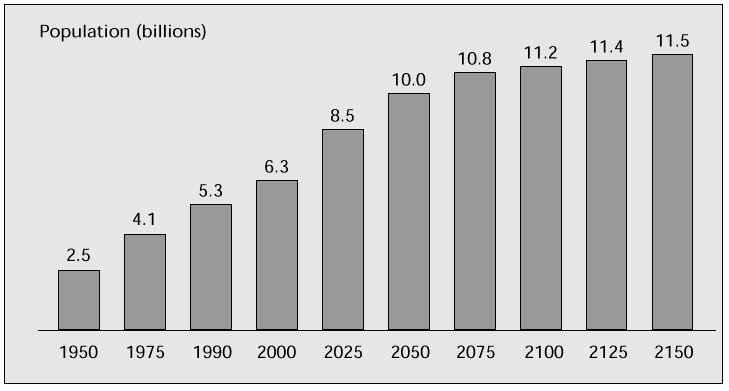
Hence the estimates and projections of the United Nations indicate that during a period of 200 years, between 1900 and 2100, the world population will increase sevenfold, from 1.65 to 11.5 billion; an increase of almost 10 billion people. However, the most dramatic change will take place in the composition of populations, as discussed below.
Population distribution
The estimated and projected distribution of the world population among the major areas and regions of the world is shown in Table II. During the 200 years between 1750 and 1950, the proportion of the African population diminished from 13.4 to 8.9% of the global total, and that of Asia from 63.5 to 55.7%. The quantitative importance of Latin America (from 2.0 to 6.6%) and Northern America (from 0.3 to 6.6%) increased. Even the European contribution increased, albeit marginally (from 20.6 to 21.8%).
Table II: Regional distribution of the global population (percentage of total) between the years 1750 and 2050 [1].

The United Nations projects that more dramatic geopolitical alterations will take place during the 100-year period from 1950 to 2050; by the year 2050, Africa’s contribution to the world population will be 21.8%, and that of Europe and Northern America only 6.9% and 3.9%, respectively. A long day’s march of our Western world into demographic irrelevance? On the other hand, the constancy of the Asian contribution to the global population will remain impressive: in the year 1750 it was 63.5%, and in the year 2050 it is projected to be 58.4% [1].
Median age
Recent estimates and projections of the median age in the various regions are shown in Table III. As late as in 1965, median age in Asia was still 20 years; by the year 2000 it will be around 26 years, and 40 years later, in the year 2040, it is projected to be almost 36 years. By that time, the median age in Europe will exceed 44 years [1].
Table III: Estimates and projections of median age (years) [1].

Life expectancy at birth
Global estimates and projections of life expectancy at birth during the 100-year period between 1950 and 2050 are indicated in Table IV [1]. Between 1950 and 2050, life expectancy at birth for men and women is projected to increase by more than 29 and 31 years, respectively, with a gender difference of almost 5 years. This indicates a global increase of 65–66% in life expectancy during the above period.
Table IV: Worldwide life expectancy at birth (years) [1].

Regional differences in life expectancy
There are major regional differences hidden behind the global averages of Table IV, as indicated by the data shown in Table V [1]. At present, life expectancy at birth is lowest in Africa and highest in North America, with a difference of almost 25 years for women and more than 20 years for men, whereas the gender difference in life expectancy is lowest in Asia (2.8 years) and highest in Europe (8.0 years). The United Nations projects that these differences will gradually diminish during the next century. The projections for the year 2050 are presented in Table VI [1]. It appears from the data of Table VI that by the year 2050, worldwide female life expectancy at birth is expected to be higher or just below 80 years of age, with the exception of Africa, where it is projected to be 75 years.
Table V: Regional life expectancy at birth (years) in the year 2000 [1].

The elderly and ‘old old’ populations
Throughout this paper, the expression ‘elderly’ denotes people aged 65 years and over and ‘old old’ indicates people aged 80 years and over [2]. These subgroups of the world population are expected to grow more rapidly than others [3]. Regional estimates for the year 1990 and projections for 2020 are presented in Table VII. During the 30 years between 1990 and 2020, the global population is expected to increase by 52%, but its elderly population will increase by 115% and the ‘old old’ population by 134% [4]. By the year 2020, more than 3.5% of the North American, and 4.4% of the European population is projected to be aged 80 years and over.
The fastest increase in the elderly population will take place in the Asian region; the projected increase between 1990 and 2025 in selected countries is shown in Table VIII. Whereas the elderly population of Sweden and of the United Kingdom is expected to increase by 33 and 45%, respectively, the corresponding increase in a number of Asian countries will be between 200 and 400% (Table VIII) [4].
Table VII: Estimated and projected total population and elderly population in 1990 and in 2020 (in millions). Medium variant projections [4].
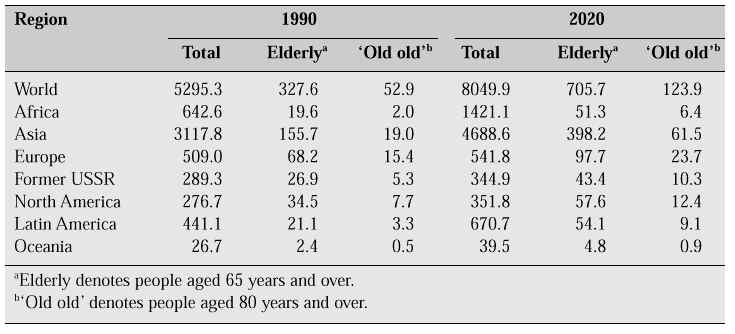
Table VIII: Projected increase in the elderly population (aged 65 years and over) between 1990 and 2025 in selected countries [4].
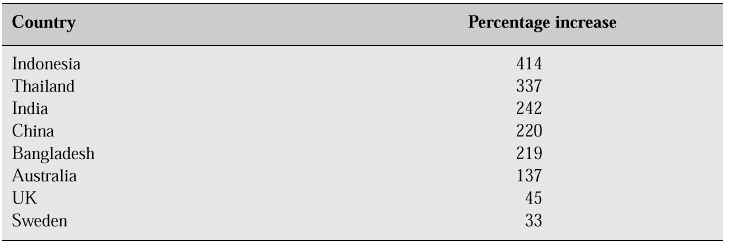
What about the ‘old old’? They constitute the fastest growing population in many, if not most, countries [5]; in fact, between 1990 and 2025, the percentage of ‘old old’ will double in Europe and treble in Asia [4].
The increase in the elderly population (as a percentage of the total) in the various regions and in a somewhat longer, centennial projection covering the period between 1950 and 2050, is presented in Table IX. It is projected that by the year 2050, approximately 15% of the global population of some 10 billion people will be elderly. The proportion of elderly will exceed 20% of the population of North America and 24% of Europe.
Table IX: Estimated and projected elderly population (65 years and over) as a percentage of the total [1].

Gender difference and the elderly
Gender difference in life expectancy at birth is accompanied by gender inequality in life expectancy also at 60 years and over; all available statistics indicate a consistent difference of several years in this respect [3]. It is therefore not too surprising that the gender gap is increasing with increasing age. In 1990, of a total world population of 5268 million people, 49.6% were women; however in the population of 328 million elderly, 57.9% were women, and among the 114 million people aged 75 years and over, 61.4% were women [1]. Because of marked regional differences, a number of countries already have a gender difference in their elderly population, which has rarely, if ever, been observed hitherto (Table X) [6].
Table X: Gender difference and the elderly: women per 100 men aged 60 years and over [6].
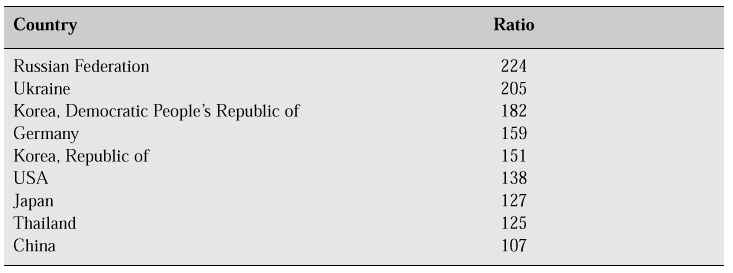
Marital status of the elderly
Marital status is an important aspect of the demographic dimension, since it is the most powerful predictor as far as the needs for socioeconomic support of the elderly population are concerned. The proportion of women and men aged 60 and over, who are not currently married and live in the 12 most populous countries of the world is presented in Table XI [6]. The marked gender difference in marital status between women and men aged 60 and over is hardly surprising; it also suggests that a high proportion of those women are widows. In fact, the results of a study requested by the United Nations General Assembly (Resolution 41/96) indicate that the proportion of elderly women who were widows in selected developing and developed countries varied between 41 and 75% [7].
Table XI: Percentage of women and men aged 60 and over in the most populous countries of the world, who are not currently married (never married, divorced, widowed) [6].
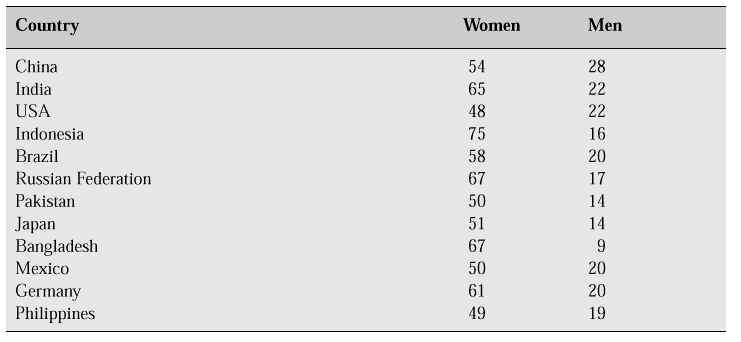
Dependent populations
These are defined as those aged 15 years and below (children) plus those who are aged 65 and over (elderly), i.e. the two tail-ends of the distribution of the population that are dependent for their existence on the support of the working-age population. The global changes in the world’s dependent population between 1950 and 2050 are shown in Table XII. It is projected that between 1950 and 2050, the elderly population of the world will increase from 5.1 to 14.7% and its population of children will diminish from 34.5 to 20.8%. Considering the various regions, the elderly population of Africa will increase from 3.2 to 7.7% and its population under 15 years of age will decrease from 42.6 to 24.4%; the elderly of Asia will increase from 4.1 to 15.3% and its population of children will decline from 36.6 to 20.1%; whereas the elderly population of Europe will increase from 8.2 to 24.4% and its population of children will decline from 26.2 to 17.1% [1]. Hence the effect of a marked increase of the elderly population in relation to the working-age population will be compounded by a simultaneous decrease in the population of children, i.e. the working-age population of the next generation. Therefore the world of 2050 will be an entirely new world; different not only from that which we imagine today, but probably also from that which we — on the basis of our contemporary perceptions — are able to imagine today.
Table XII: Dependent population of the world: estimates and projections [1].

The social dimension
Why is ageing a socioeconomic problem of the first order? Because the last years of life are accompanied by an increase in disability and sickness, with particularly high demands for social and health services and with very high costs in relation to the provision of those services. Therefore, the soaring elderly population of the world is bound to raise major socioeconomic and ethical issues and may strain to the limit the ability of the health, social and even political infrastructures of many developing countries [2, 3]. For some of the demographic reasons discussed above, ageing of the world population is very likely to result in an increasingly large proportion of the global population living in absolute poverty. Hence, in many developing countries, the majority of those surviving to old age may face a longer life of economic deprivation, with little, if any, social support. Because of the significant gender inequality in life expectancy, the majority of the elderly will be women, exposed to more disability, morbidity and poverty than men; for them, the process of ageing could well be a personal crisis of day-to-day existence and survival [2].
Therefore the impact of an ageing humankind on the quality of life of future generations is a formidable socioeconomic challenge, as emphasized by the United Nations International Conference on Population and Development [8]: ‘The steady increase in older age groups in national populations, both in absolute numbers and in relation to the working-age population, has significant implications for a majority of countries, particularly with regard to the future viability of existing formal and informal modalities for assistance to elderly people.’
The health dimension
In 1992–1993, in a unique collaborative effort, the World Bank and the World Health Organization carried out an assessment of the global disease burden, including that of the elderly populations [9]. The disease burden among the elderly of the developing world is indicated in Table XIII. According to this assessment, cerebrovascular and cardiovascular diseases and malignant neoplasms were the most important causes of disease, followed by chronic obstructive pulmonary disease and various dementias, including Alzheimer’s disease [9]. However, in our rapidly changing world, disease burden is not a static entity (perhaps it never was) and recent data reported by the World Health Organization suggest that in the not too distant future a major increase can be expected in the number of cases of Alzheimer’s disease, certain metabolic diseases such as diabetes, osteoporotic fractures, and visual and hearing impairment [10].
Table XIII: Percentage distribution of disease burden in the population aged 60 years and over in developing countries [9].
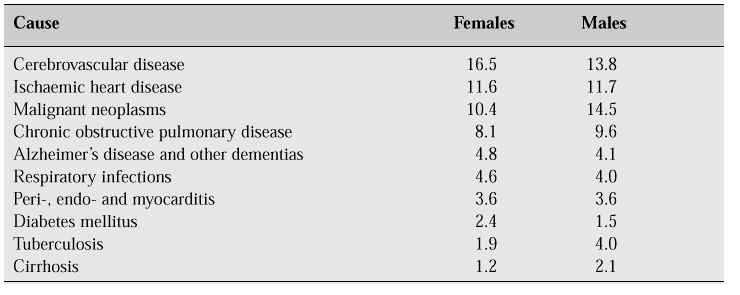
The World Health Organization points out that Alzheimer’s disease is likely to become one of the leading causes of disability in the elderly worldwide, and that Africa, Asia and Latin America between them could have more than 80 million people with senile dementia by the year 2025. The influence of increasing life expectancy on the number and regional distribution of osteoporotic fractures will also be dramatic, with several million more hip fractures than today. The number of people with diabetes is expected to double between 2000 and 2025 in Africa, the Americas, and in the Eastern Mediterranean and the Western Pacific, and it will treble in South-East Asia. Between 2000 and 2020, the number of elderly people with visual impairment is expected to increase from 100 to 180 million people and the number of those with hearing impairment from 80 to some 140 million [10].
To cope with these new realities in a cost-effective fashion, it will be essential to have a quantum leap in national and international support for medical research, including health systems research. It will also be absolutely mandatory to improve access to health services in developing countries. Indeed, lack of access to health services is still one of the most reliable indicators of human deprivation. Data on access to health services in selected countries are presented in Table XIV.
Since at the time of the study, mid-1993, the global population was 5500 million, the 2933 million people living in the 12 countries indicated in Table XIV represented more than half of the world population at that time; more than half a billion (18%) had no access to health services [11]. Who is prepared to guess how many of them would be elderly women living in absolute poverty?
Table XIV: Total population and population without access to health services from 1985 to 1993 (millions) [11].

The ethical dimension
Major social, cultural and political changes are usually accompanied by an intense debate of our ethical values, and it is easy to see that any serious debate of future social and health policy for the elderly immediately opens up a virtually endless frontier of ethical inquiry into our — not terribly consistent — moral premises.
What about the present versus the future premise: what should be an ethically justifiable allocation of scant resources among and between generations? There is an already widening gap between the generations in both developed and developing countries and intergenerational solidarity appears to be a new problem of the new times.
Then the individual versus the community premise: what should be the optimal balance between family and government obligation in providing care for the elderly?
A real and difficult problem is the premise of equity: in view of the increasing economic constraints, should there be limits of health care for the elderly and, if so, who should be the new god, deciding over life and death? How should the health establishment of future generations handle the premise of sanctity of life? How and who is going to safeguard the rights of the poor, disabled or demented elderly? What about the vexed problem of euthanasia?
A perhaps less dramatic, but very important issue is the premise of sustainability: how will the elderly be able to contribute to the maintenance of a very expensive social fabric in a world where they may constitute 25% of the world population? Indeed, how can the elderly participate fairly and effectively in determining their own fate and welfare in such a world [2, 3]?
A final comment by the World Health Organization may not be inappropriate in the ethical context: ‘Inevitably, each human life reaches its end. Ensuring that it does so in the most dignified, caring and least painful way that can be achieved deserves as much priority as any other’ [10].
Epilogue
We are living in complicated times and complicated times are always golden times for the prophets of gloom and doom. They tell us (with almost pathological enthusiasm) that all our efforts are futile, since the capacity of our Earth just cannot provide a living for a global population exceeding 10 billion (among them 25% elderly). They also tell us that our social and political institutions — be it at the national or international level — are unlikely to change rapidly and dramatically enough in order to confront the perhaps most powerful challenge of the 21st century, the rapid ageing of equally rapidly growing populations.
What the good prophets lack is a historical perspective and an adequate appreciation of the incredible amount of progress made by humankind in the 20th century, in almost a geometrical progression. In fact, never before has humankind had so many resources, so much knowledge, such powerful technologies and suitable international organizations at its disposal.
Artists and poets frequently perceive the fundamental factors governing human existence and coexistence sooner than do scientists, and scientists perceive them much sooner than do politicians. Figure 2 depicts one of the famous creations of Salvador Dali, Homme Oiseau. Indeed, such a development could well have been our destiny and evolutionary fate, with intellectual resources just enough for sheer survival, but not much more. If I belonged to the imaginary species Homo avis, I would probably share all the concerns of the prophets of ‘gloom and doom’ as far as our common future was concerned because of ‘our’ small brain volume, but being a member of another species, Homo sapiens, I just cannot agree. Indeed, I strongly believe that the extraordinary and unparalleled success of the human race as a biological species is largely attributable to the unique development of the large human brain, which has made abstract thinking possible. I also believe that abstract thinking is the alpha and omega of human development and that therefore there is no limit to what the human species may achieve in the future [12]. This was masterfully perceived by Matthew Arnold some 100 years ago: ‘Know, man hath all which Nature hath, but more, And in that more lie his hopes of good’.
The problem of ageing populations should be viewed against the above back-ground. In the history of humankind’s approach to international problems of truly global significance, six sequential phases, separated by shorter or longer lag-periods, can frequently be distinguished: (1) perception of the problem by poets and artists, (2) well-articulated rhetoric by committed scientists, (3) strong public resistance to any new idea in general and to costly ones in particular, (4) awakening and increasing awareness by the public, (5) formulation of national and international projects and programmes to address the researchable aspects of the problem, and (5) provision of public funding.
It would appear to me that with regard to healthy ageing we have just entered phases 4 and 5; this is therefore the proper time for strong advocacy by foundations, intergovernmental agencies such as the World Health Organization and UNFPA, and international professional associations such as FIGO, to impact on the international community, governments and — last, but not least — on the private sector, to mobilize adequate resources for supporting long-term research in an area of vital importance for the quality of life of humankind in the 21st century.
Fig. 2: Homme Oiseau by Salvador Dali.
References
1. United Nations Department for Economic and Social Information and Policy Analysis, Population Division. World population prospects: the 1994 revision. Document ST/ESA/SER/A/145. New York: United Nations, 1995.
2. Diczfalusy E. The third age, the Third World and the third millennium. Contraception 1996; 53: 1–7.
3. Diczfalusy E, Benagiano G. Women and the third and fourth age. Int J Gynecol Obstet 1997; 58: 177–88.
4. World Health Organization. Epidemiology and prevention of cardiovascular diseases in elderly people. WHO Tech Rep Ser 1995; 853.
5. World Health Organization, Division of Health Promotion, Education and Communication, Health of the Elderly Unit/HEE. Report of the 95th Executive Board. Document WHO/HPR/HEE/95.1. Geneva: WHO, 1995.
6. United Nations Department for Economic and Social Information and Policy Analysis, Statistical Division. The world’s women, 1995. Trends and statistics. Social statistics and indicators. Series K, no. 12. New York: United Nations, 1995.
7. United Nations Office, Vienna, Centre for Social Development and Humanitarian Affairs. The world ageing situation, 1991. Document ST/CSDHA/14. New York: United Nations, 1991.
8. United Nations. International Conference on Population and Development, Cairo, Egypt, 5–13 September 1994. Document A/CONF.171/13. New York: United Nations, 1994.
9. World Bank. World development report 1993. Investing in health. Oxford: Oxford University Press, 1993.
10. World Health Organization. The world health report 1997. Conquering suffering, enriching humanity. Geneva: WHO, 1997.
11. World Bank. World development report 1995. Workers in an integrating World. Oxford: Oxford University Press, 1995.
12. Diczfalusy E. In search of human dignity: gender equity, reproductive health and healthy ageing. The FIGO 1997 Hubert De Watteville Memorial Lecture. In: Proceedings of the XV FIGO World Congress. Carnforth, UK: Parthenon. In press.
